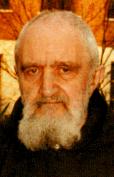Père Marie-Benoît
Marie-Benoît Péteul, O.F.M. Cap. | |
|---|---|
 | |
| Born | Pierre Péteul 3 March 1895 Bourg d'Iré, France |
| Died | 5 February 1990 (aged 94) |
| Church | Roman Catholic Church Order of Friars Minor Capuchin |
| Righteous Among the Nations |
|---|
 |
| By country |
Père Marie-Benoît (
Life before World War II
Born Pierre Péteul, Father Marie-Benoît served in World War I in North Africa, and was wounded at Verdun.[2] He received the distinction of five citations and the Croix de Guerre. After the war he joined the Franciscan Capuchin Order and earned a doctorate in theology at Rome.[3][4] In 1940 he returned to France and became a priest stationed in Marseille.[3]
Actions in wartime
In Marseille
In Marseille in 1940, he found thousands of refugees trying to escape the horrors of World War II. He was determined to help them because, in his own words,
We Christians claim to be spiritual children of the patriarch Abraham. This should be enough reason to exclude any kind of anti-Semitism whatsoever, anti-Semitism being an ideology which we Christians cannot in any way share and be part of.[2]
Father Marie-Benoît's operation focused on finding ways to successfully smuggle
In November 1942, the Nazis had occupied France's Free Zone, which included Marseille. This precluded the option of helping Jews escape to Switzerland and Spain. Accordingly, Father Benoît turned his attention to the Riviera and Haute-Savoie, occupied by the Italians.[4]
In Nice
Traveling to Nice, he persuaded Italian officials to permit Jews to cross into the Italian zone.[5] Specifically, he met with Guido Lospinoso, the Italian commissioner of Jewish affairs, whom Mussolini had sent at the Germans' insistence. Father Benoît persuaded Lospinoso to refrain from action against the 30,000 Jews who lived in the vicinity of Nice.[6][7]
Also in Nice, Father Benoît met
In Rome
In July 1943, Father Benoît traveled to Rome to seek the help of Pope Pius XII in transferring Jews to northern Africa.[3] A meeting was arranged between Father Benoît and the pope. When Father Benoit explained that the police in Vichy France were acting against the Jews, Pius XII was surprised, saying, "Who could ever expect this from noble France?"[2] He promised to diligently deal with the situation. However, the North African plan was eventually foiled when the Germans occupied northern Italy and the Italian-occupied zone of France.[6]
Father Marie-Benoît returned briefly to France in order to carry out "the Spanish part of his plan". With authority from the
Upon the urging of his friends, Father Marie-Benoît disappeared from France and resurfaced in Rome as Padre Benedetti.[7] One of his hiding places was commemorated by the International Raoul Wallenberg Foundation, a non-governmental organization which researches Holocaust rescuers and advocates for their recognition.

He was elected to the board of DELASEM (Delegazione Assistenza Emigranti Ebrei: "Delegation for the Assistance of Jewish Emigrants"), the central Jewish welfare organization in Italy of which he eventually became president.[5]
Marie-Benoît transferred the DELASEM headquarters to the International College of the Capuchins, and inaugurated an operation to forge documents there.[4][5] His office was raided several times by the Gestapo, early in 1945, with the arrest, torture, and execution of most of the rest of the DELASEM leadership, Father Benoît was persuaded to go into hiding. Against everyone's expectations, he actually survived the war.[4]
Recognition
When
On 1 December 1966, Yad Vashem officially recognized Father Benoit as a Righteous Among the Nations.[7] Overall, he helped thousands of Jews to reach Switzerland and Spain from the South of France, or escape by other means. Even while pursued by the Gestapo, he escaped to Rome, where he continued his efforts for the Jews.[2]
References and notes
- ^ "Br. Marie-Benoit: Outstanding Capuchin Humanitarian". Order of Capuchin Friars Minor. 2006-11-25. Archived from the original on 2011-06-08. Retrieved 2007-04-07.
- ^ a b c d e Capiccioni, Melanie. "Catholic Saved Thousands during Holocaust". The International Raoul Wallenberg Foundation. Retrieved 2007-04-07.
- ^ ISBN 978-1-4408-4084-5.
- ^ a b c d Altham, Elizabeth (1998). "Catholic Heroes of the Holocaust". Sursum Corda. The Augustine Club at Columbia University. Retrieved 2007-04-07.
- ^ ISBN 978-1-61069-879-5.
- ^ a b c d Yad Vashem. "Pierre-Marie Benoît". Jewish Virtual Library. American-Israeli Cooperative Enterprise. Retrieved 2007-04-07.
- ^ ISBN 978-3-8353-2150-2.
External links
- Père Marie-Benoît (in French)
- Catholic Heroes of the Holocaust
- Le parcours d’un Juste, le Père Marie-Benoît (in French)
- La Fondation Wallenberg fait mémoire d’un religieux français qui a sauvé des milliers de juifs (in French)
- Zuccotti, Susan. Père Marie-Benoît and Jewish Rescue. Bloomington: Indiana University Press, 2013.
- Père Marie-Benoît – his activity to save Jews' lives during the Holocaust, at Yad Vashemwebsite
